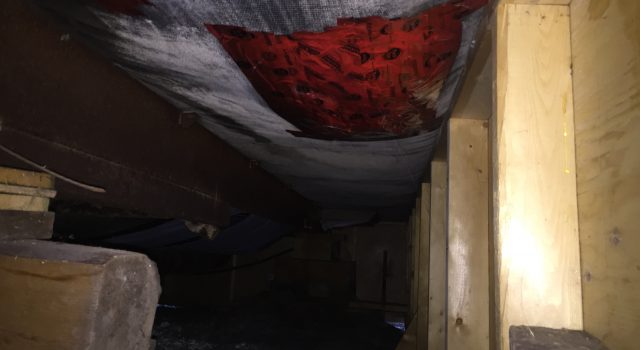You are well on the way to being an expert. An expert in maintaining your trailer. So we have identified what a trailer is. And the two different types of foundation you’ll find a trailer on.
In this post, we will be talking about the pipes under your trailer. Sewage and water. And how to protect them from freezing.
I’ll start by saying that all trailers are different. Built in different decades. Setup different from the one next door. So take this advice with a grain of salt.
The piping system in a trailer is simple. Maybe not simple to fix, but simple to understand.
Most, if not all, of your pipes will be right under the trailer floor. On the outside of the structure, but contained in a belly bag. A belly bag is a thick, strong material strapped to the underside of your trailer. The belly bag is heavily insulated. The job of the belly bag is to contain the water lines and the main heating duct of your trailer. It is insulated and retains heat and protects the trailer from the outside elements.
Let’s look at some simple tactics on how to keep your trailer in good shape throughout winter:
Heating the belly bag
The inside of the belly bag uses the heat from furnace ducts while the furnace is running to stay warm. The furnace ducts are within the belly bag and run throughout your house. The heat from these ducts should keep the belly bag well above freezing.
You should always keep the temperature within the belly bag above a minimum temperature setting that will prevent freeze-ups. If you have an old school thermostat it is a good idea to mark that setting right on the device. It is usually around 16 Celsius.
Trailer Skirting
As trailers sitting on steel pilings or wood blocks are often a few feet off the ground skirting covers up the gap. Skirting encloses the space under the trailer for several reasons.
The most common reason is to limit exposure to natural elements. If you can prevent the wind from blowing under your trailer, you’ll be able to keep the crawlspace warmer and help the belly bag to retain heat better.
If you can, and especially with older trailers with low insulation levels in the belly bag, insulate the skirting is a good idea and one that requires little maintenance. The cheaper solution, for those without insulated skirting, is to pile snow up around your trailer. The snow then becomes the insulation and prevents any drafts getting under the trailer.
Another reason for skirting around your trailer is to prevent animals from entering the crawlspace. Especially cats, and their feces. Do a check occasionally for any large gaps where animals would be able to fit in.
Keep Water Flowing
Making sure you have a sealed belly bag and furnace that is heating it will help prevent freeze-ups. Do not only rely on this, though. Running the taps and flushing toilets on a daily basis is essential to preventing freeze-ups. Doing this prevents stagnant water from freezing. This is why having a house-sitter is so important in Yellowknife, especially in the winter. Make sure that the taps in the kitchen and bathrooms are not running continuously. A small amount of water moving slowly along the sewer line is more likely to result in freeze-up. Also, check the toilets for silent leaks. Again, a small amount of water running continuously will result in freeze ups.
Using Heat Tape
Under certain trailers around town, you might see pipes outside of the belly bag. For example, under my trailer, I have a sewage pipe that runs the length of the trailer before going underground. The best way to make sure that the sewer line will not freeze is to insulate the entire length of the pipe with R20 fiberglass insulation wrapped around the pipe. The insulation should be protected with a moisture barrier, usually a clear plastic.
Using heat tape on the sewer pipes is a common practice but it is extremely important to make sure that the heat tapes are specifically designed for plastic piping. Too often people use heat tapes intended for copper pipes. This can result in melting the plastic piping and possibly starting a fire. Only self-regulating heat tapes, installed by a professional should be used on combustible pipes. Using electric heat tape will also result in higher electricity bills.
This is basic and straightforward information about maintaining trailer pipes in most Yellowknife trailers. I would also encourage trailer owners to inspect the condition of the insulation around the water and sewer pipes before every winter to make sure that the insulation is dry. Wet/frozen insulation will again result in a freeze up.
Did we miss something? Send us a message and let me know.
This series is in part supported by Housecheck Yellowknife. Didier Bourgois of Housecheck Yellowknife provides pre-sale and pre-purchase home inspections as well as consulting services. Check out his website at housecheckyellowknife.ca
Trailer Series:
Maintaining a Trailer in Yellowknife: Part 1 – What is a Trailer?
Maintaining a Trailer in Yellowknife: Part 2 – Foundation
Maintaining a Trailer in Yellowknife: Part 3 – Pipes








